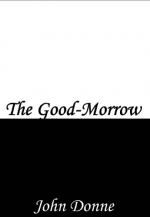
|
| Name: _________________________ | Period: ___________________ |
This test consists of 15 multiple choice questions and 5 short answer questions.
Multiple Choice Questions
1. How many lines does "The Good-Morrow" contain?
(a) 28.
(b) 26.
(c) 21.
(d) 23.
2. Which term describes the use of the word "beauty" in line 6?
(a) Metonymy.
(b) Appositive.
(c) Pun.
(d) Hyperbole.
3. Which technique is used repeatedly in the first quatrain?
(a) Understatement.
(b) Rhetorical question.
(c) Paradox.
(d) Appeal to Ethos.
4. Where does the poet describe what the lovers see in one another's faces?
(a) Line 17, "better hemispheres."
(b) Line 18, "sharp north" and "declining west."
(c) Line 16, "true plain hearts."
(d) Line 13, "worlds on worlds."
5. What is the dominant meter of this poem?
(a) Trochaic pentameter.
(b) Trochaic hexameter.
(c) Iambic pentameter.
(d) Iambic hexameter.
6. What do the poem's final three lines suggest is true about the speaker's and his lover's relationship?
(a) Their relationship already feels as if it has gone on forever.
(b) Because they love and give an equal amount, their love is immortal.
(c) He wishes that she would give as much to the relationship as he does.
(d) The power of their love can overcome any real-world obstacles.
7. Lines 12-14, "Let sea-discoverers to new worlds have gone,/ Let maps to other, worlds on worlds have shown,/ Let us possess one world, each hath one, and is one," contain an example of which technique?
(a) Cacophony.
(b) Anaphora.
(c) Antimetabole.
(d) Onomatopoeia.
8. Which word in lines 15-18 is meant to contrast the impermanent nature of life outside the lovers' relationship with the eternal nature of their love?
(a) "Rest" (line 16).
(b) "Declining" (line 18).
(c) "Sharp" (line 18).
(d) "Plain" (line 16).
9. What imperfection does line 18 suggest exists in the real northern hemisphere?
(a) It is stressful.
(b) It is ugly.
(c) It is boring.
(d) It is cold.
10. Which term best describes the rhyming in lines 13 and 14, "Let maps to other, worlds on worlds have shown,/ Let us possess one world, each hath one, and is one"?
(a) Eye rhyme.
(b) Slant rhyme.
(c) Identical rhyme.
(d) True rhyme.
11. Which term describes this poem most accurately?
(a) Aside.
(b) Epistle.
(c) Dialogue.
(d) Apostrophe.
12. What does the phrase "'Twas so" in line 5 mean?
(a) It makes clear that the whole stanza is hypothetical, not a reality.
(b) It introduces the logical consequences of the ideas offered in lines 1-4.
(c) It confirms that the possibilities outlined in lines 1-4 were actually true.
(d) It creates a shift in time, indicating that lines 5-7 take place in the future.
13. What is the literal meaning of the poem's title?
(a) The good soul.
(b) The good day after.
(c) The good news.
(d) The good morning.
14. Which techniques are seen in line 15, "My face in thine eye, thine in mine appears"?
(a) Consonance and inversion.
(b) Sibilance and euphony.
(c) Assonance and internal rhyme.
(d) Alliteration and antithesis.
15. What is the rhyme scheme within each stanza?
(a) ABABABA.
(b) AABBCCC.
(c) ABABCCC.
(d) ABCABCA.
Short Answer Questions
1. In line 14, "Let us possess one world, each hath one, and is one," what two things are being compared?
2. How many additional syllables does the final line in each stanza contain?
3. What is the time of day in this poem's setting?
4. What kind of fear is the speaker referring to in line 9?
5. Line 10, "For love, all love of other sights controls," contains an example of which technique?
|
This section contains 526 words (approx. 2 pages at 300 words per page) |

|




